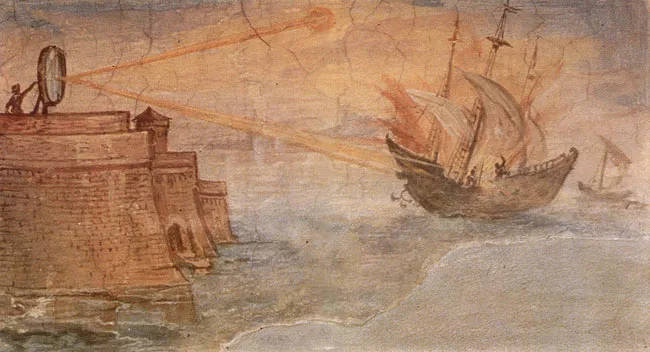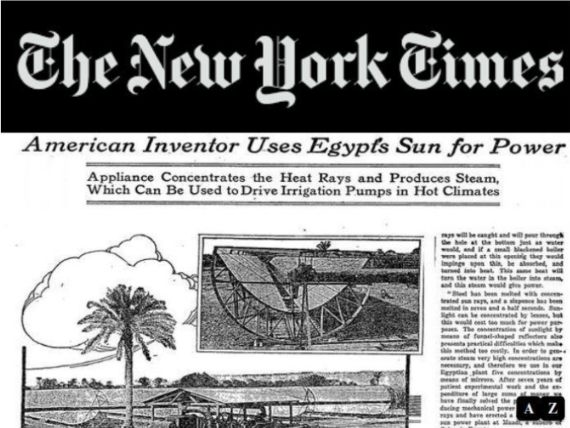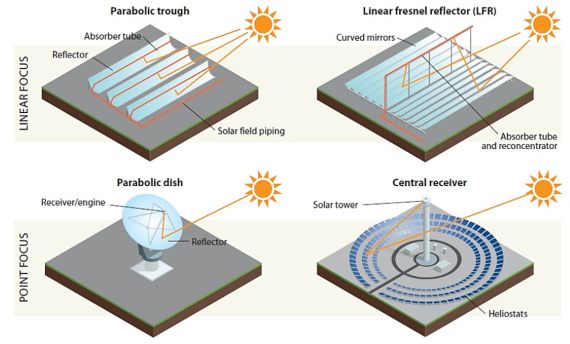Along with photovoltaic solar energy and wind energy, there is another renewable technology that takes advantage of our main energy resource, the sun, to produce electricity: solar thermoelectric, thermosolar or concentrating solar power. Its operating principle is based on the use of mirrors that concentrate the sun’s radiation to obtain steam, which is then directed towards the blades of a turbine to move them and thus produce electricity. In this sense, it is similar to fossil fuel or uranium-based technologies in that what it does is move the turbines of a generator, but without burning gas or fissioning uranium.
Known as Concentrating Solar Power (CSP), this technology’s ability to store the energy produced can provide flexible, renewable energy, 24 hours a day, 7 days a week, in regions with excellent direct solar resources. This article describes the main features of this technology.
BRIEF HISTORY OF CSP
The idea of using mirrors to concentrate solar radiation to heat a given object or fluid is not new. The Greek scientist Archimedes used the reflective properties of bronze shields to set fire to Roman ships besieging Syracuse in 212 B.C. during the Second Punic War. Although there are doubts about the veracity of this unique story, the experience has subsequently been successfully recreated, proving the effectiveness of concentrating sunlight to generate heat. The following image shows a painting from the Ufizzi gallery in Florence illustrating Archimedes’ alleged contraption:

Mural painting (Giulio Parigi, 1600) depicting the huge bronze mirror supposedly built by Archimedes to reflect the sun’s rays on the Roman ships besieging Syracuse to set them on fire. Stanzino delle Matematiche, Uffizi Gallery (Florence, Italy)
Despite the first modern commercial CSP plants being built in the 1980s, the technology has a long history dating back to the late 19th century, when it was used to power the first solar steam engine. Given the excellent solar resources found in the MENA region, it is not surprising that the first parabolic trough systems were installed there in 1912, near Cairo (Egypt). The system was designed to generate steam for a pump that supplied 2,000 m3/h of water for irrigation. It should be noted that even in 1912, CSP plant technology was regionally competitive with coal-fired steam generating facilities.

In the 1970s, when the United States became a net energy importer, President Richard M. Nixon created several research groups to examine the potential of new renewable technologies to make the United States energy independent again. In 1972, the Federal Council for Science and Technology concluded that the technologies for generating solar thermal power could provide 20% of the country’s energy needs by 2020. Given the prohibitive costs of solar photovoltaic technology at the time, it was assumed that all solar energy would be thermal. After the 1973 oil crisis, the U.S. federal CSP research budget tripled. But as oil prices fell in the 1980s, and Reagan-era budget cuts reduced research and development, the sector stagnated until the early 2000s.
At the beginning of this century, in Spain, following the publication of the famous Royal Decree 661/2007 generous premiums for electricity production encouraged developers to start up CSP projects, making Spain the world leader in this technology in terms of installed capacity 2,300 MW), a position it still holds today. Despite this, the deployment of new projects stagnated when these premiums were cut in 2008-2010, a situation that, as far as CSP technology is concerned, has not changed substantially since then.
Fundamentals of CSP plants
As mentioned above, CSP plants are based on the use of mirrors that concentrate direct radiation from the sun onto a receiver filled with a fluid, usually thermal oil or molten salts. This fluid, called heat transfer fluid, conducts heat to an exchanger where it is used to generate steam. The steam is then directed under pressure to a turbine to move its blades and produce electrical energy, following a procedure similar to that used in conventional thermal power plants. Broadly speaking, a CSP plant consists of three main units:
- Solar collectors, which are mirrors that reflect sunlight and concentrate it on a certain focus, converting solar energy into thermal energy.
- A means of heat storage by means of water vapor or molten salts.
- An electric power generator, which produces electricity via a turbine driven by steam that has been obtained from the conversion of solar radiation into heat.
CSP plants are of four main types: linear parabolic trough concentrators, Fresnel lens concentrators, tower concentrators and parabolic mirror concentrators (Stirling concentrators) Stirling concentrators). The following shows the four, the fundamentals of which are briefly described in the next paragraph:

The four types of solar thermal power plants from top to bottom and from left to right: Linear concentrators; Fresnel mirrors; parabolic mirror and tower concentrators
– Linear concentrators: their operation is based on capturing the sun’s energy using U-shaped curved rectangular mirrors directed towards the sun; they collect the light and concentrate it in tubes that run parallel along the mirrors, located on the focal line of the mirrors. The reflected sunlight heats a fluid that circulates through the tubes. This fluid is then used to produce steam in a conventional turbine generator that produces electricity.
– Fresnel mirrors: like the previous ones, the receiver tube is located above several mirrors that are positioned at different angles so that they all redirect the solar radiation towards the tube.
– Parabolic mirror: they make use of a circular mirror similar to the dishes used in satellite dishes for satellite television signals. The surface of the disk receives the sunlight and redirects it by concentrating it on a thermal receiver, which absorbs and collects the heat and transfers it to a piston engine, similar to the pistons of internal combustion engines. This system uses the fluid heated by the receiver to move the motor pistons and transform the heat energy into mechanical energy. Subsequently, the mechanical energy is used to drive a generator to produce electricity.
– Tower concentrators: they use a large field of flat mirrors called heliostats to focus and concentrate the sunlight on a receiver located on top of a tower (the image at the beginning of this article shows a field of these solar collectors). A fluid is heated in the receiver and used to generate steam which, in turn, is used in a conventional turbine generator to produce electricity. Some towers use water as the fluid, while other advanced designs are experimenting with molten nitrate salts due to their superior heat storage capabilities.
In an upcoming article, I will describe the pros and cons of this technology and its deployment in the world today.
Ignacio Mártil
Professor of Electronics at the Complutense University of Madrid and member of the Spanish Royal Society of Physics
Author of the book Energía solar: De la utopía a la esperanza (Análisis y crítica)
Comments on this publication